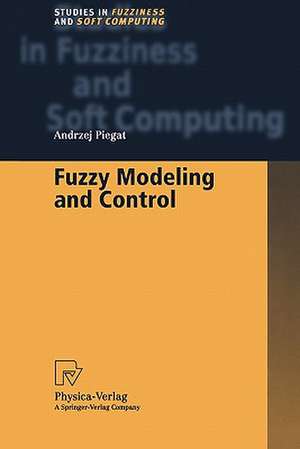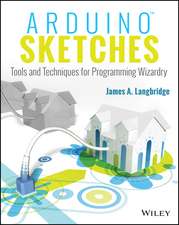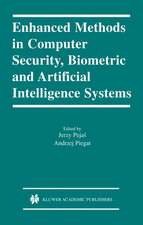Fuzzy Modeling and Control: Studies in Fuzziness and Soft Computing, cartea 69
Autor Andrzej Piegaten Limba Engleză Paperback – 6 noi 2010
| Toate formatele și edițiile | Preț | Express |
|---|---|---|
| Paperback (1) | 1919.85 lei 6-8 săpt. | |
| Physica-Verlag HD – 6 noi 2010 | 1919.85 lei 6-8 săpt. | |
| Hardback (1) | 1926.81 lei 6-8 săpt. | |
| Physica-Verlag HD – 8 mai 2001 | 1926.81 lei 6-8 săpt. |
Din seria Studies in Fuzziness and Soft Computing
- 20%
 Preț: 999.85 lei
Preț: 999.85 lei - 20%
 Preț: 653.06 lei
Preț: 653.06 lei - 20%
 Preț: 872.96 lei
Preț: 872.96 lei - 20%
 Preț: 930.57 lei
Preț: 930.57 lei - 20%
 Preț: 1051.00 lei
Preț: 1051.00 lei - 20%
 Preț: 992.44 lei
Preț: 992.44 lei - 20%
 Preț: 655.85 lei
Preț: 655.85 lei - 20%
 Preț: 1001.86 lei
Preț: 1001.86 lei - 18%
 Preț: 954.14 lei
Preț: 954.14 lei - 20%
 Preț: 330.10 lei
Preț: 330.10 lei - 20%
 Preț: 333.04 lei
Preț: 333.04 lei - 20%
 Preț: 997.56 lei
Preț: 997.56 lei -
 Preț: 391.61 lei
Preț: 391.61 lei - 20%
 Preț: 647.79 lei
Preț: 647.79 lei - 20%
 Preț: 986.01 lei
Preț: 986.01 lei - 18%
 Preț: 958.56 lei
Preț: 958.56 lei - 20%
 Preț: 996.40 lei
Preț: 996.40 lei - 20%
 Preț: 999.35 lei
Preț: 999.35 lei - 15%
 Preț: 646.43 lei
Preț: 646.43 lei - 20%
 Preț: 651.57 lei
Preț: 651.57 lei - 20%
 Preț: 997.89 lei
Preț: 997.89 lei - 15%
 Preț: 641.03 lei
Preț: 641.03 lei - 20%
 Preț: 1009.74 lei
Preț: 1009.74 lei - 20%
 Preț: 992.62 lei
Preț: 992.62 lei -
 Preț: 388.72 lei
Preț: 388.72 lei - 18%
 Preț: 1223.43 lei
Preț: 1223.43 lei - 20%
 Preț: 651.42 lei
Preț: 651.42 lei - 18%
 Preț: 951.59 lei
Preț: 951.59 lei - 18%
 Preț: 948.61 lei
Preț: 948.61 lei
Preț: 1919.85 lei
Preț vechi: 2399.82 lei
-20% Nou
Puncte Express: 2880
Preț estimativ în valută:
367.41€ • 383.09$ • 305.35£
367.41€ • 383.09$ • 305.35£
Carte tipărită la comandă
Livrare economică 20 martie-03 aprilie
Preluare comenzi: 021 569.72.76
Specificații
ISBN-13: 9783790824865
ISBN-10: 3790824860
Pagini: 744
Ilustrații: XIV, 728 p.
Dimensiuni: 155 x 235 x 39 mm
Greutate: 1.03 kg
Ediția:Softcover reprint of hardcover 1st ed. 2001
Editura: Physica-Verlag HD
Colecția Physica
Seria Studies in Fuzziness and Soft Computing
Locul publicării:Heidelberg, Germany
ISBN-10: 3790824860
Pagini: 744
Ilustrații: XIV, 728 p.
Dimensiuni: 155 x 235 x 39 mm
Greutate: 1.03 kg
Ediția:Softcover reprint of hardcover 1st ed. 2001
Editura: Physica-Verlag HD
Colecția Physica
Seria Studies in Fuzziness and Soft Computing
Locul publicării:Heidelberg, Germany
Public țintă
ResearchCuprins
1. Introduction.- 1.1 Essence of fuzzy set theory.- 1.2 Development of fuzzy set theory.- 2. Basic Notions of Fuzzy Set Theory.- 2.1 Fuzzy sets.- 2.2 Characteristic parameters (indices) of a fuzzy set.- 2.3 Linguistic modifiers of fuzzy sets.- 2.4 Types of membership functions of fuzzy sets.- 2.5 Type 2 fuzzy sets.- 2.6 Fuzziness and probability: two kinds of uncertainty.- 3. Arithmetic of Fuzzy Sets.- 3.1 The extension principle.- 3.2 Addition of fuzzy numbers.- 3.3 Subtraction of fuzzy numbers.- 3.4 Multiplication of fuzzy numbers.- 3.5 Division of fuzzy numbers.- 3.6 Peculiarities of fuzzy numbers.- 3.7 Differences between fuzzy numbers and linguistic values.- 4. Mathematics of Fuzzy Sets.- 4.1 Basic operations on fuzzy sets.- 4.2 Fuzzy relations.- 4.3 Implication.- 5. Fuzzy Models.- 5.1 Structure, main elements and operations in fuzzy models.- 5.2 Significant features of rules, rule bases and fuzzy models.- 5.3 Advice relating to rule base construction.- 5.4 Reduction of the rule base.- 5.5 Normalization (scaling) of the fuzzy model inputs and output.- 5.6 Extrapolation in fuzzy models.- 5.7 Types of fuzzy models.- 6. Methods of Fuzzy Modeling.- 6.1 Fuzzy modeling based on the system expert’s knowledge.- 6.2 Creation of fuzzy, self-tuning models based on input/output measurement data of the system.- 6.3 Creation of self-organizing and self-tuning fuzzy models based on input/output measurement data of the system.- 7. Fuzzy Control.- 7.1 Static fuzzy controllers.- 7.2 Dynamic fuzzy controllers.- 7.3 The determination of structures and parameters for fuzzy controllers (organization and tuning).- 8. The Stability of Fuzzy Control Systems.- 8.1 The stability of fuzzy control systems with unknown models of plants.- 8.2 The circle stability criterion.- 8.3 The application of hyperstability theory to analysis of fuzzysystem stability.- References.
Textul de pe ultima copertă
In the last ten years, a true explosion of investigations into fuzzy modeling and its applications in control, diagnostics, decision making, optimization, pattern recognition, robotics, etc. has been observed. The attraction of fuzzy modeling results from its intelligibility and the high effectiveness of the models obtained. Owing to this the modeling can be applied for the solution of problems which could not be solved till now with any known conventional methods. The book provides the reader with an advanced introduction to the problems of fuzzy modeling and to one of its most important applications: fuzzy control. It is based on the latest and most significant knowledge of the subject and can be used not only by control specialists but also by specialists working in any field requiring plant modeling, process modeling, and systems modeling, e.g. economics, business, medicine, agriculture,and meteorology.
Caracteristici
Survey of effective methods used today in fuzzy modeling and control by means of geometric bodies and surfaces, enabling the reader to use them in construction of own algorithms Problem vizualization by over 640 illustrations and numerous examples Includes new results and methods Includes supplementary material: sn.pub/extras











